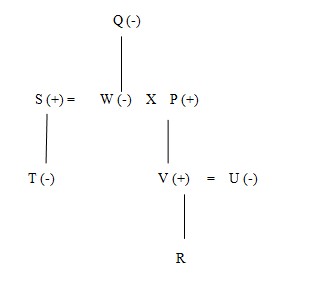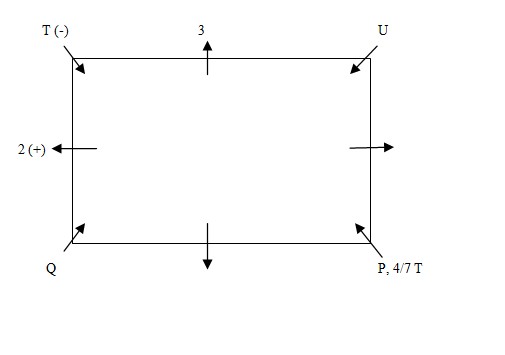Question
Which of the following statements is true?
Read the following information carefully and answer the questions given below it: P, Q, R, S, T, U, V and W are sitting around a square table in such a way that four of them who sits at the corner are facing towards the centre and other four who sits in the middle of the table are facing outside the centre. Each person has different number of coins viz. 1, 2, 3, 4, 5, 6, 7 and 8, but not necessarily in the same order. Only one person sits between W and V. V sits second to the right of the person who has 8 coins. W’s brother S, sits on the immediate left of his mother who has 6 coin. P is the father of V and only one person sits between W’s mother and T. S’s daughter sits second to the right of U and on the immediate left of that person who has 3 coins. Q sits second to the left of W’s husband who has neither 4 nor 7 coins. U, who is sister of V, has 7 coins and is not an immediate neighbour of W’s husband. T sits on the immediate right of the person who has 2 coins. S’s daughter has 1 coin. Only one person is sitting between P and U. No female is an immediate neighbour of Q, who sits at the corner of the table. V is father of R and is not an immediate neighbour of T. P is married to W.Solution
W’s brother S, sits on the immediate left of his mother who has 6 coins. P is the father of V and only one person sits between W’s mother and T. U, who is sister of V, has 7 coins and is not an immediate neighbour of W’s husband. V is father of R and is not an immediate neighbour of T. P is married to W. By the statement ‘only one person sits between W’s mother and T’, we find that Q is W’s mother and T is S’ daughter.  No female is an immediate neighbour of Q, who sits at the corner of the table. Q sits second to the left of W’s husband who has neither 4 nor 7 coins. Only one person is sitting between P and U. S’s daughter sits second to the right of U and on the immediate left of that person who has 3 coins. T sits on the immediate right of the person who has 2 coins.
No female is an immediate neighbour of Q, who sits at the corner of the table. Q sits second to the left of W’s husband who has neither 4 nor 7 coins. Only one person is sitting between P and U. S’s daughter sits second to the right of U and on the immediate left of that person who has 3 coins. T sits on the immediate right of the person who has 2 coins.  S, sits on the immediate left of his mother who has 6 coins. V is not an immediate neighbour of T. So, V can sit at immediate right or immediate left to P. If V sits immediate right to P, and as we know that W is female so she sit at immediate left to T. We know that V sits second to the right of the person who has 8 coins. By this statement this condition is not possible. If V sits immediate left to P, so W will sit at immediate right to P. Then R will sit at immediate left to T. Further V sits second to the right of the person who has 8 coins. It is given that T has 1 coin and that of U is 7. So V will have 4 and P will have 5 coins
S, sits on the immediate left of his mother who has 6 coins. V is not an immediate neighbour of T. So, V can sit at immediate right or immediate left to P. If V sits immediate right to P, and as we know that W is female so she sit at immediate left to T. We know that V sits second to the right of the person who has 8 coins. By this statement this condition is not possible. If V sits immediate left to P, so W will sit at immediate right to P. Then R will sit at immediate left to T. Further V sits second to the right of the person who has 8 coins. It is given that T has 1 coin and that of U is 7. So V will have 4 and P will have 5 coins 
According to Mahatma Gandhi's 'Hind Swaraj' (1909), British rule in India was established _____.
Which of the following rulers of the Gupta Empire is described as 'Maharajadhiraja'?
Who amongst the following composed ‘Risalo’?
Who initiated the first school for Muslim girls in British India?
Consider the following statements regarding the Alipore Bomb Conspiracy Case, 1908:
1. Revolutionaries who threw the bomb were Prafulla Chaki and...
The Jallianwala Bagh massacre took place in which year
Who served as the Chairman of the first Law Commission of British India?
Which of the events occurred during the active phase of the Revolutionary Movement (1907- 1917)?
1. Formation of Hindu Mahasabha
2. Separa...
The Rowlatt Act was passed in which year?
Consider the following movements and arrange them in chronological order:
1. Eka Movement.
2. Tebhaga Movement.
3. Bardoli S...


